XU1 XDH-040U Handleiding
Bekijk gratis de handleiding van XU1 XDH-040U (2 pagina’s), behorend tot de categorie Hamer. Deze gids werd als nuttig beoordeeld door 79 mensen en kreeg gemiddeld 4.8 sterren uit 40 reviews. Heb je een vraag over XU1 XDH-040U of wil je andere gebruikers van dit product iets vragen? Stel een vraag
Pagina 1/2

SAFETY
INSTRUCTIONS
ALWAYS WEAR EYE, FACE
AND EAR PROTECTION
When operating the tool
Electrical safety
Using an extension lead
Description of symbols
Demolition Breaker Safety
Warnings
XU1 Power tools
iSC GmbH, Eschenstraße 6, D-94405 Landau, Germany
Telephone: GB: 0151 294 4488 / IRL: 1850 882711
XDH-040U 0416
Keep the mains cable away from any moving parts or
accessories.
Never cover the ventilation slots in the tool.
General Power Tool Safety
Warnings
WARNING! Read all safety
warnings and all instructions. Failure
to follow the warnings and instructions may
result in electric shock, re and/or serious
injury.
Save all warnings and instructions
for future reference. The term “power
tool” in all of the warnings refers to your
mains-operated (corded) power tool or battery-
operated (cordless) power tool.
Read instruction manual
The electric motor has been designed for 230-240V
only. Always check that the power supply corresponds
to the voltage on the rating plate.
Always use an approved extension lead suitable for
the power input of this tool. Before use, inspect the
extension lead for signs of damage, wear and ageing.
Replace the extension lead if damaged or defective.
When using an extension lead on a reel, always
unwind the lead completely. Use of an extension lead
not suitable for the power input of the tool or which is
damaged or defective may result in a risk of re and
electric shock.
The power supply for this product should be protected
by a residual current device (rated at 30mA or less).
A residual current device reduces the risk of electric
shock.
If the supply cord is damaged, it must be replaced
by the manufacturer, its service agent or similarly
qualied persons in order to avoid a hazard.
This tool is double insulated; therefore no earth
wire is required.
1) Work area safety
a) Keep work area clean and well lit.
Cluttered and dark areas invite accidents.
b) Do not operate power tools in
explosive atmospheres, such as in the
presence of ammable liquids, gases or
dust.
Power tools create sparks which may ignite the dust
or fumes.
c) Keep children and bystanders away
while operating a power tool. Distractions can
cause you to lose control.
2) Electrical safety
a) Power tool plugs must match the
outlet. Never modify the plug in any
way. Do not use any adapter plugs with
earthed (grounded) power tools. Unmodied
plugs and matching outlets will reduce risk of electric
shock.
b) Avoid body contact with earthed
or grounded surfaces such as pipes,
radiators, ranges and refrigerators. There
is an increased risk of electric shock if your body is
earthed or grounded.
c) Do not expose power tools to rain or
wet conditions. Water entering a power tool will
increase the risk of electric shock.
d) Do not abuse the cord. Never use the
cord for carrying, pulling or unplugging
the power tool. Keep cord away from
heat, oil, sharp edges or moving parts.
Damaged or entangled cords increase the risk of
electric shock.
e) When operating a power tool outdoors,
use an extension cord suitable for
outdoor use. Use of a cord suitable for outdoor
use reduces the risk of electric shock.
f) If operating a power tool in a damp
location is unavoidable, use a residual
current device (RCD) protected supply.
Use of an RCD reduces the risk of electric shock.
3) Personal safety
a) Stay alert, watch what you are doing
and use common sense when operating a
power tool. Do not use a power tool while
drugs, alcohol or medication. A moment of
inattention while operating power tools may result in
serious personal injury.
b) Use personal protective equipment.
Always wear eye protection. Personal
protective equipment such as dust mask, non-skid
safety shoes, hard hat, or hearing protection used for
appropriate conditions will reduce personal injuries.
c) Prevent unintentional starting. Ensure
the switch is in the off-position before
connecting to power source and/or
battery pack, picking up or carrying the
tool. Carrying power tools with your nger on the
switch or energising power tools that have the switch
on invites accidents.
d) Remove any adjusting key or wrench
before turning the power tool on. A wrench
or a key left attached to a rotating part of the power
tool may result in personal injury.
e) Do not overreach. Keep proper footing
and balance at all times. This enables better
control of the power tool in unexpected situations.
f) Dress properly. Do not wear loose
clothing or jewellery. Keep your hair,
clothing and gloves away from moving
parts. Loose clothes, jewellery or long hair can be
caught in moving parts.
g) If devices are provided for the
connection of dust extraction and
collection facilities, ensure these are
connected and properly used. Use of dust
collection can reduce dust-related hazards.
4) Power tool use and care
a) Do not force the power tool. Use the
correct power tool for your application.
The correct power tool will do the job better and safer
at the rate for which it was designed.
b) Do not use the power tool if the switch
does not turn it on and off. Any power tool
that cannot be controlled with the switch is dangerous
and must be repaired.
c) Disconnect the plug from the power
source and/or the battery pack from
the power tool before making any
adjustments, changing accessories, or
storing power tools. Such preventive safety
measures reduce the risk of starting the power tool
accidentally.
d) Store idle power tools out of the reach
of children and do not allow persons
unfamiliar with the power tool or these
instructions to operate the power tool.
Power tools are dangerous in the hands of untrained
users.
e) Maintain power tools. Check for
misalignment or binding of moving parts,
breakage of parts and any other condition
that may affect the power tools operation.
If damaged, have the power tool repaired
before use. Many accidents are caused by poorly
maintained power tools.
f) Keep cutting tools sharp and clean.
Properly maintained cutting tools with sharp cutting
edges are less likely to bind and are easier to control.
g) Use the power tool, accessories
and tool bits etc. in accordance with
these instructions and in the manner
intended for the particular type of power
tool, taking into account the working
conditions and the work to be performed.
Use of the power tool for operations different from
those intended could result in a hazardous situation.
5) Service
a) Have your power tool serviced by
a qualied repair person using only
identical replacement parts. This will ensure
that the safety of the power tool is maintained.
Original Instructions
XDH-040U
1600W
Demolition
Hammer Kit
WARNING!
This appliance is not intended for use by
persons (including children) with reduced
physical, sensory or mental capabilities,
or lack of experience and knowledge,
unless they have been given supervision or
instruction concerning use of the appliance
by a person responsible for their safety.
• Wear ear protectors. Exposure to noise
can cause hearing loss.
• Use auxiliary handle(s), if supplied
with the tool. Loss of control can cause
personal injury.
• Hold power tool by insulated gripping
surfaces, when performing an
operation where the cutting accessory
may contact hidden wiring or its own
cord. Cutting accessory contacting a “live”
wire may make exposed metal parts of
the power tool “live” and could give the
operator an electric shock.
• Young children should be supervised
to ensure that they do not play with the
appliance.
• Always use an approved extension lead
suitable for the power input of this tool.
Before use, inspect the extension lead
for signs of damage, wear and ageing.
Replace the extension lead if damaged or
defective.
• When using an extension lead on a reel,
always unwind the lead completely. Use
of an extension lead not suitable for
the power input of the tool or which is
damaged or defective may result in a risk
of re and electric shock.
• It is recommended that the extension lead
is a maximum of 25m in length. Do Not
use multiple extension leads.
• Before drilling into walls, ceilings etc,
ensure there are no concealed power
cables or pipes in the cavity.
• Always use the side handle, this gives you
greater control if the accessory should
become jammed.
• Keep the cord clear of the accessory being
used, do not wrap the cord around your
arm or wrist.
• Hold the tool by the insulated gripping
surfaces when performing an operation
where the accessory may contact hidden
wiring or its own cord.
• Use thick cushioned gloves and limit the
exposure time by taking frequent breaks.
• Vibration caused by the hammer action
may be harmful to your hands and arms.
• When removing an accessory from the
tool avoid contact with skin and use proper
protective gloves when grasping the bit or
accessory. Accessories may be hot after
prolonged use.
32
WARNING!
Some dust created by power sanding,
sawing, grinding, drilling and other
construction activities contain chemicals
known to cause cancer, birth defects or other
reproductive harm.
Some examples of these chemicals are:
• Lead from lead-based paints;
• Crystalline silica from bricks, cement and
other masonry products, and;
• Arsenic and chromium from chemically-
treated timber.
The risk from such exposures vary
depending on how often you do this type
of work. To reduce your exposure to these
chemicals; work in a well ventilated area,
and work with approved safety equipment,
such as those dust masks that are
specically designed to lter out microscopic
particles.
Always wear eye protection and a dust mask
for dusty applications and when drilling/
chiselling overhead. Sanding particles can
be absorbed by your eyes and inhaled easily
and may cause health complications.
Do not expose to rain
Wear dust mask
Wear ear protection
Wear eye protection
Double insulated
Volts
Hertz
Watts
Warning
Alternating current
Revolutions, reciprocations or strokes per
minute
No load speed
/min
n
o
V
Hz
W
WARNING! When using mains-powered equipment,
basic safety precautions, including the following, should
always be followed to reduce risk of re, electric shock,
personal injury and material damage.
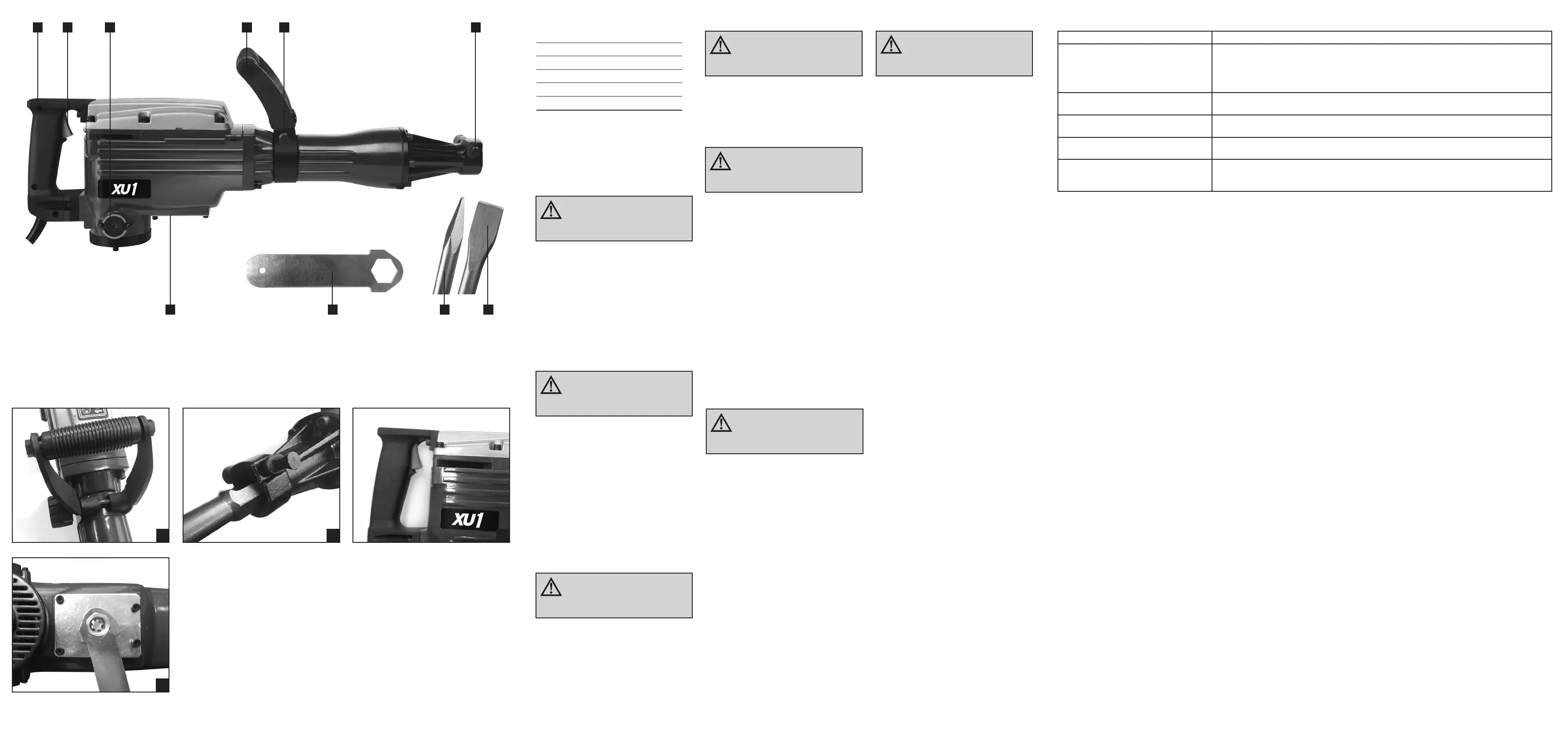
Power: 1600W
Impact Energy: 43 Joules
Impact Rate: 1800 /min
Chuck: 30mm Hex
Noise Level: 105dB
Weight: 14.7kg
1 2 3 4 5 6
8 9 10
7
A B C
D
1. Rear Handle
2. On/Off Trigger
3. Accessible Brush Covers
4. Adjustable Secondary Handle
5. Secondary Handle Securing knob
6. Accessory Chuck
7. Oil View Window
8. Spanner
9. Pointed Chisel
10. Flat Chisel
SPECIFICATIONS
USING YOUR
DEMOLITION
BREAKER
OPERATION MAINTENANCE TROUBLESHOOTING
Keep the ventilation slots of the demolition breaker
clean at all times. If possible prevent foreign matter from
entering the vents.
After each use, blow air through the tool housing to
ensure it is free from all dust particles that may build up.
CAUTION: Excessive build-up of dust
particles may cause the demolition
breaker to overheat and fail.
If the enclosure of the tool requires cleaning, use a soft,
moist cloth only. Do not use solvents.
CAUTION: Never immerse any part of the
tool in liquid.
Carbon brushes will wear out after many uses, causing
the tool to spark and/or stop. The brushes are a wearing
component of the demolition breaker and should be
replaced prior to the carbon wearing out completely.
Take the tool to a suitably qualied electrician or power
tool repairer for replacement. Always replace both
brushes at the same time.
Note: XU1 will not be responsible for any damage
or injuries caused by the repair of the tool by an
unauthorised person or by mishandling of the tool.
Checking the Oil Level
The oil level should be checked before each use.
1. Lay the tool on its side with the base facing you.
2. Inspect the oil view window. The level should be half
way up the view window.
3. If the level is lower than this then you must add more
oil following the procedure below.
Adding Oil
The oil tank is approximately 45ml therefore you should
add oil in small amounts.
Recommended Oil: SAE 15W/40 or an alternative of the
same quality.
1. Lay the tool upside down so that the view window is
facing up.
2. Unscrew the view window anti-clockwise using the
supplied spanner. FIG. D
3. Add a small amount of oil through the view window
hole.
4. Screw the view window back in and tighten using the
supplied spanner in a clockwise direction.
5. Recheck the oil level and repeat this process if
necessary.
On/Off Switch
• To turn the demolition breaker on, squeeze the on/off
switch. FIG. C
• To turn the tool off, release the on/off switch.
Using the Demolition Breaker
For best penetration rates in concrete, run the
demolition breaker with a steady pressure, but do not
use excessive force as this will decrease the efciency
of the tool.
1. Ensure the accessory and secondary handle are
secure.
2. Position the tip of the tool in the desired starting
position.
3. Ensure you have a stable stance and hold the tool
rmly with both hands.
4. Press the on/off trigger to begin operation.
5. Apply steady pressure to allow the tool to break
through the material.
6. Once the tool has completed the rst pass through
the material, reposition and repeat.
WARNING! Be sure to disconnect the
tool from the power supply before tting or
removing accessories.
WARNING! Ensure the tool is
disconnected from the power supply before
performing any of the following operations.
This tool is intended for use in a DIY (Do It Yourself)
context or for hobbyist purposes. It is not built for
continuous daily use in a trade or professional capacity.
Before using the machine, carefully read these
instructions, especially the safety rules to help ensure
that your machine always operates properly.
Before attempting to operate the machine, familiarise
yourself with the controls and make sure you know how
to stop the machine quickly in an emergency.
Save these instructions and the other documents
supplied with this machine for future reference.
Secondary Handle
The secondary handle must be tted securely before
operating the demolition breaker. The handle can be
adjusted to suit all users by simply rotating into the
desired orientation.
1. Loosen the secondary handle securing knob by
rotating anti-clockwise.
2. Rotate the handle into the desired position.
3. Tighten the secondary handle securing knob to
secure in position. FIG. A
Fitting Accessories
1. Pull the accessory chuck bolt out as far as possible
then rotate 180 degrees and release.
2. Insert the accessory into the chuck. FIG. B
3. Pull the accessory chuck bolt out and rotate 180
degrees to secure the accessory
4. Ensure the accessory is secure by trying to pull it out.
Note: The accessory should slide in the chuck but not
be able to be removed.
WARRANTY
All of our products undergo strict quality checks to ensure that they reach you in perfect condition. In the unlikely event that your device develops a
fault, please contact our service department at the address shown on this guarantee card. You can also contact us by telephone using the customer
service number shown. Please note the following terms under which guarantee claims can be made:
1. These warranty terms regulate additional warranty services, which the manufacturer mentioned below promises to buyers of its new products in
addition to their statutory guarantee claims are not affected by this guarantee. Our guarantee is free of charge to you.
2. The warranty services only covers defects due to material or manufacturing faults on a product which you have bought from the manufacturer
mentioned below are limited to either the rectication of said defects on the product or the replacement of the product, whichever we prefer.
Please note that our devices are not designed for use in commercial, trade or professional applications. A guarantee contract will not be created if the
device has been used by commercial, trade or industrial business or has been exposed to similar stresses during the guarantee period.
3. The following are not covered by our guarantee:
- Damage to the device caused by a failure to follow the assembly instructions or due to incorrect installation, a failure to follow the operating
instructions (for example connecting it to an incorrect mains voltage or current type) or a failure to follow the maintenance and safety instructions or by
exposing the device to abnormal environmental conditions or by lack of care and maintenance.
- Damage to the device caused by abuse or incorrect use (for example overloading the device or the use or unapproved tools or accessories), ingress
of foreign bodies into the device (such as sand, stones or dust, transport damage), the use of force or damage caused by external forces (for example
by dropping it).
- Damage to the device or parts of the device caused by normal or natural wear or tear or by normal use of the device.
4. Your Product is guaranteed for a period of 12 months from the original date of purchase and is intended for DIY (Do It Yourself) use only. Warranty
excludes consumable parts, for example: drill and chisel bits. Guarantee claims should be submitted before the end of the guarantee period within
two weeks of the defect being noticed. No guarantee claims will be accepted after the end of the guarantee period. The original guarantee period
remains applicable to the device even if repairs are carried out or parts are replaced. In such cases, the work performed or parts tted will not result
in an extension of the guarantee period, and no new guarantee will become active for the work performed or parts tted. This also applies if an on-site
service is used.
IN ORDER TO MAKE A CLAIM UNDER THIS WARRANTY YOU MUST RETURN THE PRODUCT TO THE PLACE OF PURCHASE WITH YOUR
REGISTER RECEIPT.
Please refer to the restrictions of this warranty concerning wearing parts, consumables and missing parts as set out in the service information in these
operating instructions.
CUSTOMER SERVICE HELPLINE
GB: 0151 294 4488 / IRL: 1850 882711
XU1 Unit 9 Stadium Court, Wirral International Business Park, Plantation Road, Bromborough, Wirral, CH62 3QG
5
WARNING! The power supply for this
product should be protected by a residual
current device (rated at 30mA or less).
WARNING! After use, hold the tool away
from your body until the demolition breaker
stops completely. This may help to prevent
serious injury.
4 6
IMPORTANT! Always lubricate the
accessory tment prior to inserting. Using
your nger apply grease sparingly to the shaft
of the accessory.
IMPORTANT! Do not use the at chisel as
a “pry bar” as this will damage the at chisel
and potentially the demolition breaker. Such
damage will void your warranty.
WARNING! Ensure the tool is
disconnected from the power supply before
performing any of the following operations.
Sympton Solution
Not chiselling or low breaking power Tool temperature is low
Accessories not lubricated
Refer to insert of Cold Hammering (below) on how to resolve this issue
Accessory is jammed/stuck in concrete during use Release the accessory locking mechanism, allowing the demolition breaker to be separated from the accessory.
The accessory should be easily removed from the concrete once it is detached from the demolition hammer.
Accessory repeatedly becomes stuck while in use Free the accessory as described above. Refrain from penetrating too deeply with the chisel bit, as it is prone to
becoming stuck when demolishing large pieces of concrete.
A small amount of sparking is visible through the
housing air vents
This is normal and does not indicate a problem.
Excessive sparking is visible through the housing
air vents and/or the demolition breaker is failing to
operate
This may indicate the carbon brushes have worn out and need to be replaced. Carbon brushes should only be
replaced by a qualies electrician or power tool repairer.
Cold Hammering
If the demolition hammer is stored for long periods of time of at cold temperatures, the lubrication may become stiff and the demolition hammer may
not hammer initially or the hammering may be weak.
Should this occur, insert an accessory into the demolition hammer, turn the demolition hammer on and apply the end of the accessory against a scrap
piece of concrete or timber. Turn the demolition hammer on and off every few seconds. After 15 seconds to 2 minutes, the demolition hammer should
have started to hammer normally. The colder the demolition hammer, the longer it may take to warm up and function like normal.
Note: Always wait until the accessory has stopped moving before putting down the demolition hammer.
Product specificaties
| Merk: | XU1 |
| Categorie: | Hamer |
| Model: | XDH-040U |
Heb je hulp nodig?
Als je hulp nodig hebt met XU1 XDH-040U stel dan hieronder een vraag en andere gebruikers zullen je antwoorden
Handleiding Hamer XU1

16 Maart 2024
Handleiding Hamer
- Ozito
- Bosch
- Toolson
- Daewoo
- AEG
- Stanley
- Graphite
- DeWalt
- Gude
- Draper
- Powerplus
- Porter-Cable
- Goon
- Cocraft
- Parkside
Nieuwste handleidingen voor Hamer
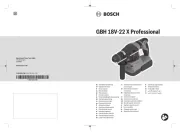
15 September 2025
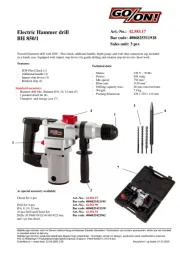
3 September 2025
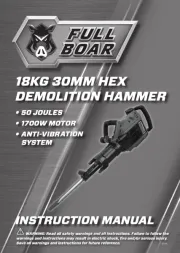
1 September 2025
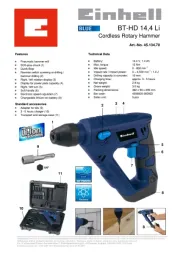
27 Augustus 2025
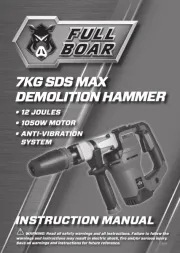
26 Augustus 2025
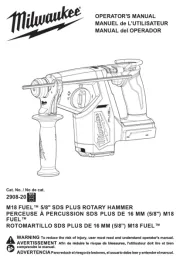
19 Augustus 2025
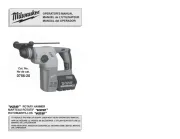
19 Augustus 2025
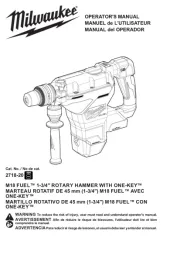
19 Augustus 2025
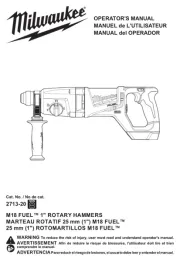
18 Augustus 2025
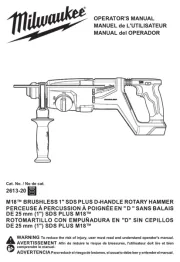
18 Augustus 2025